Thirteen thousand years ago, the Age of Great Mammals came crashing to a close in the Western Hemisphere. Lost were the giants of the elephant clan: the mammoths, mastodons, and gomphotheres, which had maintained a presence in North America for twenty million years. The native horses, a tall camel, and all but one species of pronghorn—each group from a lineage thought to have originated in North America—vanished from the plains. Gone, too, were the strange beasts that had evolved in South America during millions of years of continental isolation: ground sloths as massive as elephants, hippo-like toxodons, and lumbering, spike-tailed glyptodonts, which looked uncannily like the ankylosaurs that had shared the Cretaceous landscape with T. rex.
These large herbivores (along with the biggest bear, the biggest canid, and several big cats, all of which depended upon the plant eaters) disappeared in a geological instant. Evidence is mounting that newly arrived humans with formidable stone-tipped spears of Clovis design were to blame.1 This “extinction of the massive” that marks the end of the Pleistocene epoch ravaged the megafauna. What happened to the plants?
We cannot be sure. Leaves and flowers and seeds are not preserved as readily as bone. Plant lineages restricted to upland habitats may come and go without a trace. Bogs and lakes, of course, receive a shower of pollen, often from vast distances. But detectable quantities of pollen preserved in sediments are restricted to wind-pollinated plants—notably, grasses, conifers, and many deciduous trees of our temperate forests. (And of these, some produce pollen that can be distinguished only at the genus or even family level.) Indeed, fossil pollen from stratified bog and lake sediments is the primary evidence used to reconstruct the vegetational shifts that accompanied the repeated coolings and warmings of the Pleistocene epoch.
The Pleistocene pollen record shows only one tree extinction (a species of spruce) in North America near the end of the epoch.2 Is there reason to suspect that plants pollinated by insects, birds, or bats—that is, plants with little or no pollen record—might have been more vulnerable to extinction?
The answer is yes, but vulnerability to extinction in this case has nothing to do with the mode of pollination. Many plants that are pollinated by animals rather than by wind produce fleshy fruits whose seeds are dispersed by other, larger animals. Plants dependent on megafauna for dispersal would indeed have been vulnerable to range reduction or even outright extinction when their partners in evolution and ecology vanished.
Riddle of the Rotting Fruit
Ecologist Dan Janzen speculates that although fossil evidence is lacking, some fruit-bearing plants probably did follow the megafauna into extinction.3 These plants would have begun to decline when their megafaunal seed dispersers vanished. Some might have gone extinct relatively soon after losing their partners. Others, especially the long-lived and those that regenerate clonally from their roots as well as from seed, still survive but may ultimately be on track for extinction. Still others have been regenerated as domesticated cultivars by humans fond of their fruit or other botanical qualities. But by and large Janzen thinks that those that are still here today suffered significant reductions in range when important members of their disperser guilds were extinguished.
The narrowly restricted ranges of some of today’s big-fruited plants suggest that Janzen may be right: plant extinctions may, in fact, have stemmed from the animal extinctions. An indicator that something is amiss is evident in the case of trees whose fleshy fruits fall and rot beneath the canopy of the parent. It was this “riddle of the rotting fruit” that captured Janzen’s attention twenty-five years ago while he was studying the ecology of Costa Rican plants. It made no sense for plants to waste energy by building pulp that attracted few if any dispersers. Worse, in the case of many fleshy fruits, when the pulp rots, the embedded seeds are killed as well. What was going on here?
In 1982 Dan Janzen, with paleoecologist Paul Martin, published a paper in the journal Science titled “Neotropical Anachronisms: The Fruits the Gomphotheres Ate.”4 Janzen had carried out field studies in Costa Rica to learn whether introduced livestock (horses and cattle) served as surrogate Pleistocene megafauna for the bereft plants. The result: a list of some thirty species of trees and vines of the Costa Rican dry forest whose fruits bear the physical and ecological characteristics of “ecological anachronisms.”5 These plants are living in a time warp; they are adapted for a lost world. Their missing animal partners are “the ghosts of evolution.”
Anachronisms and ghosts caught the early attention of Robert E. Cook, who is the director of the Arnold Arboretum. Citing Janzen and Martin, Cook published an essay in 1982 in Natural History that described the avocado, Persea americana, as an ecological anachronism that has been stunningly successful in attracting a replacement dispersal agent: us.6 Within the past few hundred years, avocado has been taken from the New World tropics to orchards in Florida, California, northern Mexico, and far beyond this hemisphere. Wild elephants who raid village fruit trees in Africa are now “planting” American avocado on that continent.7
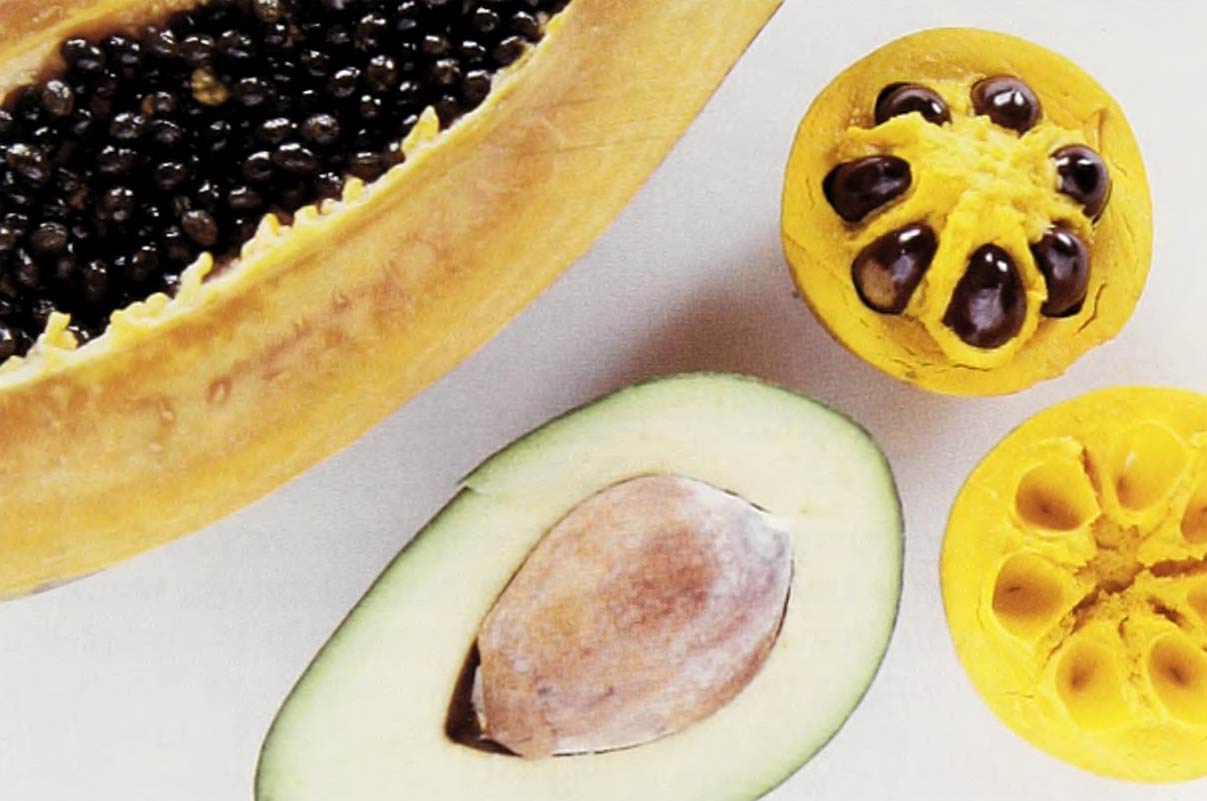
In their landmark paper, Dan Janzen and Paul Martin concentrated on Costa Rican plants. But in the final paragraph they extrapolated the anachronism concept to large-fruited plants of the eastern and central United States: kentucky coffee tree (Gymnocladus dioicus), honey locust (Gleditsia triacanthos), pawpaw (Asimina triloba), persimmon (Diospyros virginiana), and osage orange (Maclura pomifera).
To a plant lover, the notion that ghosts may be haunting some of the most magnificent native fruits of one’s homeland is a revelation. It was quite a surprise, therefore, when I began the library research four years ago for my book The Ghosts of Evolution (2001) to discover that virtually no effort had been made to test these five temperate plants or to identify other possible anachronisms in the forests and fields of North America. Indeed, scientists currently breeding honey locust trees to increase the fodder value of their pods, and those developing improved pawpaw cultivars and promoting the use of their fruit, have been doing so unaware that the fruits are anachronistic.
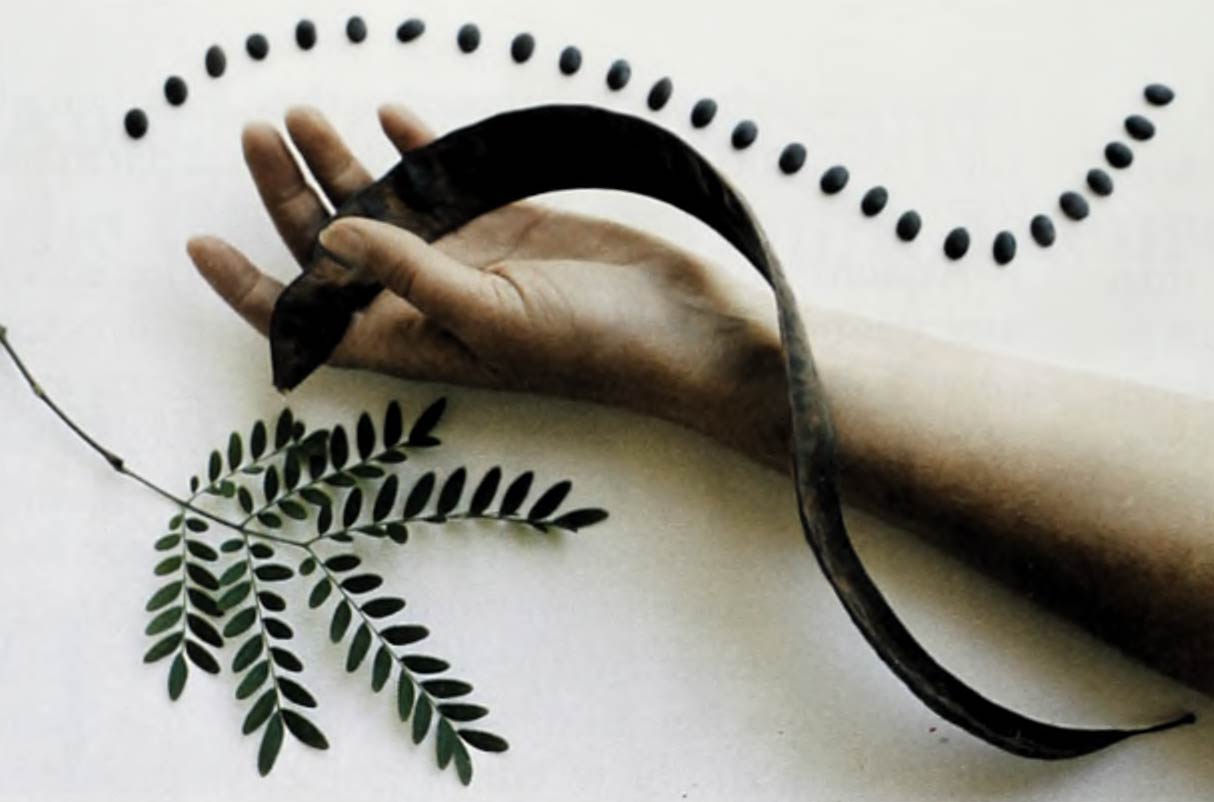
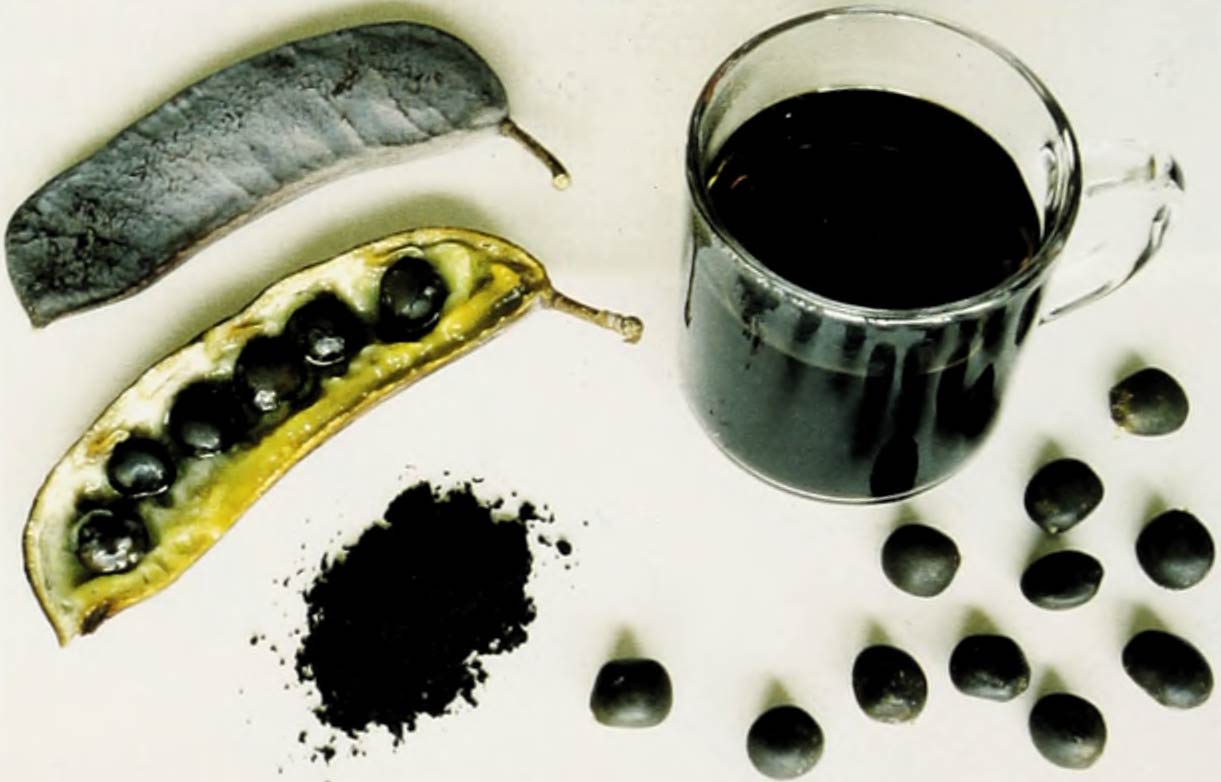
Osage Orange—An Extreme Anachronism
Recently, I spoke with an archeologist, Frank Schambach, who felt frustrated because nowhere in the published literature could he find the information he needed to solve the ecological puzzle of osage orange—information crucial for validating his thesis that before settlers began rearranging the landscape, the wood of this tree, highly valued for making hunting bows, may have been traded far and wide in North America under the complete control of a single indigenous tribe.8 Schambach suspected that osage orange (also known as bois d’arc, “wood of the bow”) occupied a very constricted range that could in fact be claimed by a single tribe.
Osage orange would more appropriately have been named osage breadfruit. A close relative to Maclura, of America, and to its sister genus Cudrania, of eastern Asia, is the breadfruit genus, Artocarpus. All are linked through the mulberry family, a largely tropical family dominated by the figs and striking for its members’ compound fruits and the white latex some exude when cut. Osage orange was named after the Osage Indians of Missouri, who first introduced white traders to this strange fruit—the color of a glow-green tennis ball and about the size and firmness of a softball.
Inhabitants of the plains and prairie states know this fruit by another name: hedge apple. Until the invention of barbed wire in 1874, there was no more effective or economical way to fence free-ranging livestock out of one’s vegetable garden or cornfield than to plant a hedge of thorny osage orange stems, later interweaving the abundant root suckers that the trees send up in response to severe pruning. Thus osage orange gained a replacement dispersal agent, and its range expanded rapidly.
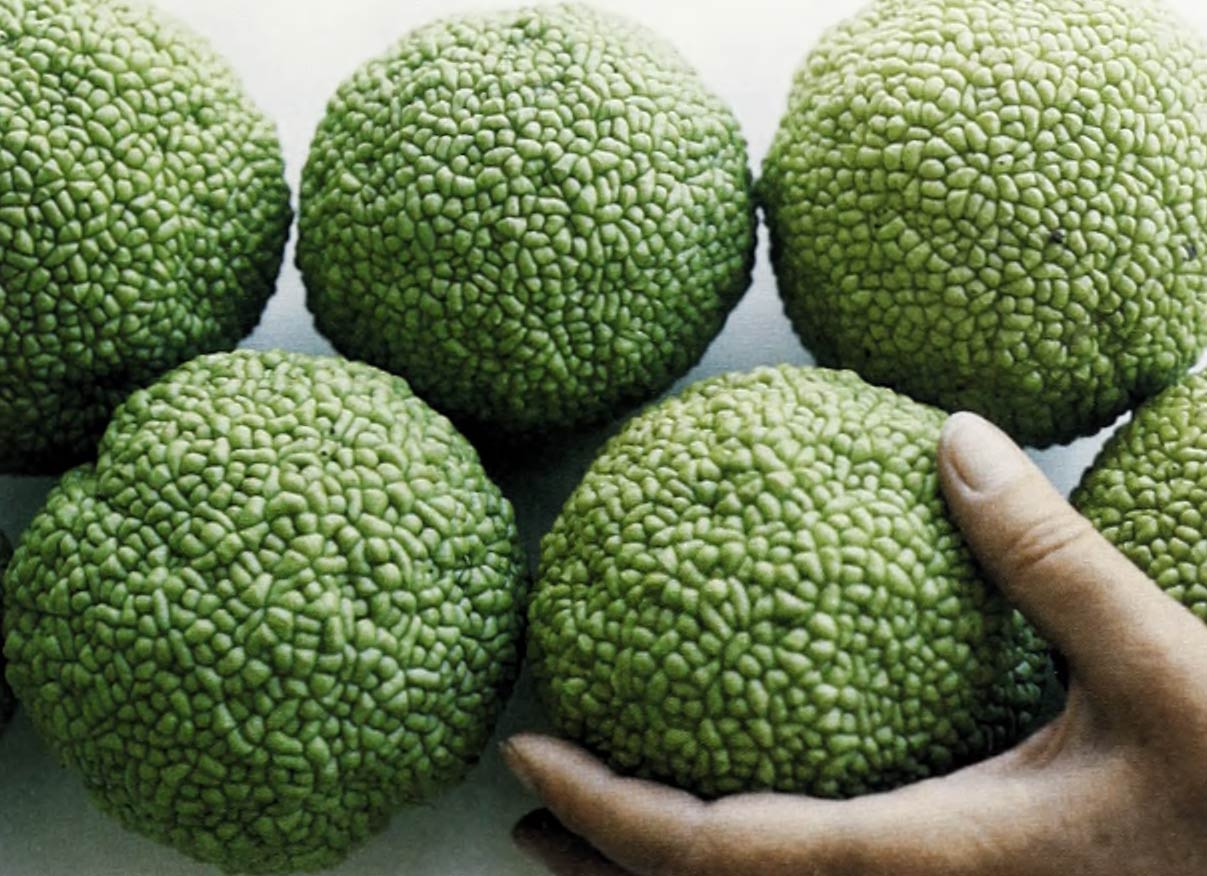
Maclura pomifera, a wind-pollinated tree, is known from pollen samples to have been wide ranging in North America during earlier ice-free phases of Cenozoic history. But by the time of European contact, its range had shrunk considerably: just before its transformation into a common hedge plant, it inhabited only a small stretch of the Red River watershed near the junction of Texas, Oklahoma, and Arkansas. Frank Schambach suspects that at its nadir the range was even more restricted—possibly limited to the Bois d’Arc tributary of the Red River in Texas and nearby creeks of the adjacent Blackland Prairie. Such isolation would explain how a single tribe—the Spiroans of Mississipian culture—could have controlled the entire bow wood trade. And this, in turn, would explain the archeological evidence of extraordinary wealth accumulated by this people in the centuries prior to European contact.
What ecological information did Schambach need to solve his archeological puzzle? He wanted to know whether horses spread osage orange—that is, do horses eat the fruit and defecate viable seeds? If so, then by the time naturalists got around to documenting the geographic reach of osage orange, its renaissance had already been initiated by horses, which had been reintroduced into North America in the sixteenth century. Surely amateur naturalists and people living wherever osage orange and ranch horses co-exist know the answer to the question—it seems to be yes. But the matter isn’t discussed in the published literature. Thus a core contention in Schambach’s “Spiroan trader” theory rests on what he has been able to glean from Red River ranchers and his own casual observations.
The search continues. A year after publication of his “Spiroan trader” theory, Schambach obtained crucial anecdotal information: “A volunteer at my dig this summer lives on a ranch on the Blackland Prairie in east Texas,” Schambach wrote me. “She has a small herd of horses which, she assures me, routinely eat osage orange fruits on their own. Furthermore, she knows for a fact that horses spread the tree via their manure because when she and her husband acquired their property there was no osage orange growing on the upland (prairie) parts of it, only in the bottomlands along the creeks. But soon after they began pasturing horses on the land, the osage orange began to migrate out of the bottoms, and it is now growing all over their prairie areas, to their dismay.”
Here’s another intriguing story that came my way while I was writing this article—this one from Robert M. Timm, professor of ecology and evolutionary biology at the Umversity of Kansas. Timm has horses and one mule on his farm in Kansas. They all “love the fruits” of osage orange, he wrote me. “The mule is the best at locating them, but if you are experienced with mules that wouldn’t be a surprise. They are always much more curious and more exploratory than horses. I’d say of all the natural foods around here, osage orange fruits are the mule’s favorite. He seems to remember them from one year to the next, but that too is typical of mules. I have no doubt that Pleistocene horses would have long-term memory of favorite trees to feed at every fall.”
Timm is very familiar with Dan Janzen’s anachronism theory and has been casually observing mice, rabbits, and tree squirrels feeding on the pulp and seeds. “They don’t cache osage orange,” he observes, “they eat it on the spot.” Most intriguing is his discovery of large quantities of shredded, freshly fallen fruit in the stomachs of deer. All these mammals great and small are indeed eating the fruit, but are they dispersing the seed? Timm concludes no.
Timm acquires buckets of osage orange fruits from neighbors and spreads them on the unpastured sections of his own property as supplemental feed for wildlife. Nevertheless, he has encountered no seedling trees. “I picked up another five gallon bucket of fruits this morning,” Timm wrote me as this article went to press, “and I’ll check here in a few weeks to see if the seeds make it intact through a mule’s digestive tract. I’ll pull the mule and horses off the pasture later this month and keep them in a paddock for the winter and give the mule fruits where it will be easy for me to retrieve the seeds.”
Overall, anachronism theory seems to be anecdotally well supported for horses as dispersal agents of osage orange. Are there any other plausible ghosts to pair with this native fruit besides Pleistocene horses?
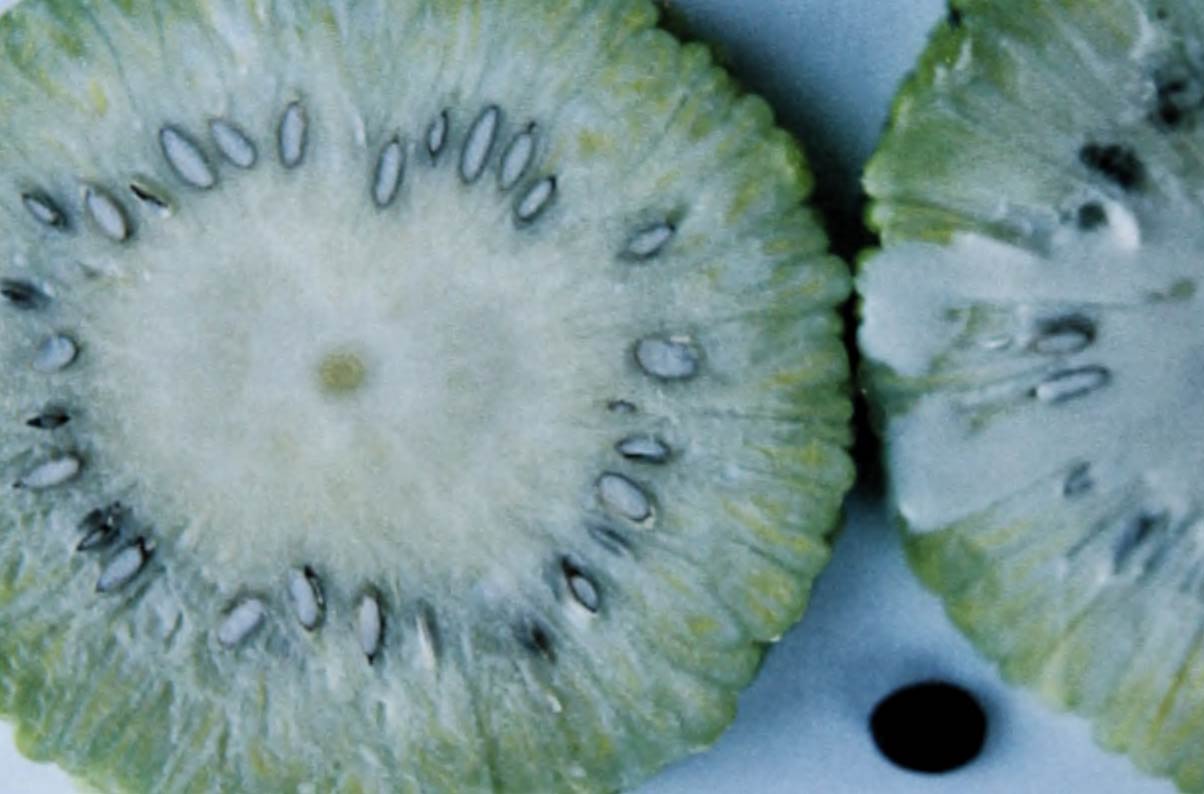
Paul Martin and I had a chance to test osage orange vicariously on a much bigger Pleistocene surrogate: African elephants at the Brookfield Zoo in Chicago. Almost surely this was the first time since the Pleistocene that the fruit of Maclura pomifera had met the molar of a proboscidean. I sent a box of freshly fallen fruit to Martin, which he in turn forwarded to the Brookfield Zoo. After a search of the literature, zoo staff decided that there was no danger in offering the elephants a few fruits.
The results were inconclusive. At first, the youngest two elephants didn’t want to even touch the fruits offered by their keepers. Finally, each curled a trunk around a sphere and hurled the offensive object out of their habitat. The matriarch, however, chose to sample the first fruit offered, chewing and swallowing. But she would then accept no more.
Herbivores are known to be wary of novel foods. Cultural knowledge of gastronomic possibilities, passed from one generation to the next in social animals, would not be available to zoo elephants. Then too, well-fed captive animals will often turn up their noses at foods that their wild counterparts would happily consume. The case is therefore still to be made that Pleistocene mastodons and mammoths would have joined horses in dispersing osage orange fruits in North America. But it will be a most interesting hypothesis to pursue—for anyone excited by the theory and who has access to elephants!
Powers of Persistence
It is perhaps no coincidence that the five species of temperate American trees judged anachronistic by Dan Janzen and Paul Martin are all prodigious cloners. Vegetative means of reproduction would have helped these trees persist for the thirteen thousand years that sexual reproduction has been disrupted for want of adequate seed dispersal.
Kentucky coffee tree, honey locust, pawpaw, persimmon, and osage orange all send up root suckers—prolifically so when the main stem is pruned or otherwise damaged. Kentucky coffee and pawpaw are extraordinarily skilled in growing lateral root runners that sprout new stems many meters from the elder stem, supported by photosynthates supplied by the parent. Indeed, a few years ago when a pawpaw tree “died” of old age in the Arnold Arboretum, more 19 than a hundred fresh stems popped up almost immediately from a vast network of root runners. And although the Arboretum isolates its mature kentucky coffee specimens by encircling the trees with a wide buffer of mowed lawn, grounds staff must periodically rid neighboring beds of the vigorous fresh stems emanating from hidden root runners.
As the ice retreated from its last southward advance, which peaked about twenty thousand years ago, four of the five above-mentioned anachronistic trees of eastern and central North America would have been helped to reclaim former territory by newly arriving humans. Pawpaw and persimmon fruits would have been carried back to camp, their seeds removed or spit out at the time of eating. Honey locust pods would have been opened and licked for their sweet matrix, the hard seeds discarded. Kentucky coffee trees were valued not for their fruit but for their large, nearly spherical seeds, which took a lovely polish and were used for gaming tokens. Although the wood of osage orange was highly prized and known to have been traded across great distances in the time just prior to European contact, the fruits held little if any value. Does this perhaps explain why the range of osage orange became so constricted?
Is the Endangered Torreya Tree Anachronistic?
Coming to terms with the likelihood that native horses almost certainly and elephants probably were effective seed dispersers of osage orange during the Pleistocene and for several tens of millions of years before that provides fresh insights into how to rescue from extinction a severely endangered American tree, Torreya taxifolia (florida torreya). Torreya is a conifer of the plum yew family, Cephalotaxaceae, and thus bears no fruit as botanically defined. Nevertheless, the fleshy design of its diaspore—ecologically a fruit—is an obvious lure for animals. Like a yew or a ginkgo, torreya produces single large seeds enveloped in what ought to be viewed as fruits by vertebrate dispersers.
The proximate cause of Torreya taxifoha’s imminent extinction, and thus the cause that gets all the attention, is disease. Some thirty pathogens are known to infest it, but no single disease seems to be the culprit.9 Once common in the rich soils of the Apalachicola River of northern Florida, adult specimens growing in the wild suddenly began to die in the 1950s, and none remain today. Like the American chestnut that was destroyed by (an imported) blight during the early years of the twentieth century, torreya survives only because new stems keep sprouting from the same rootstock. Sadly, each fresh sprout of torreya is doomed to die before it is old enough to produce pollen or ova. Energy stored in the roots will eventually give out, since new starts in the shady forest may consume more photosynthate than they can return to the roots before their demise.
The genus Torreya was once distributed throughout the Northern Hemisphere. Range fragmentation has created distinct species in eastern China, patches of the Coast Range and the Sierras of California, and the Apalachicola of Florida. The geographic range of the Florida species is today restricted to the cool ravines along the east side—only the east side—of a 22- mile (35-km) stretch of the Apalachicola River in northern Florida. During the coldest times of the Pleistocene, the Apalachicola, with its moderate climate and rich soils, was a refuge for the trees and forbs that now enrich the Cove Hardwood forest of Great Smoky Mountains National Park, 375 miles (600 km) to the north. After the ice retreated, most of the plants hitched rides from wind and animals and moved back north to their pre-glacial home. Torreya seems to have been left behind.
Some experts confirm that the tree’s troubles may have begun for want of a disperser. 10 Global or regional extinction of an animal partner (or partners) may be the root cause of the tree’s current distress. Torreya is probably not ideally suited for the warmth and humidity of today’s Apalachicola region. It wants to head north, but it hasn’t found a vehicle.
That florida torreya may be haunted by the ghosts of extinct dispersers is suggested by a host of clues. First, the diaspore of all species of Torreya is distasteful or toxic to many (possibly all) mammals who normally consume fruits. The pulp has a high terpene content and it leaves a sticky residue on one’s skin. Squirrels treat the fruit as they treat ginkgo fruit m New York City’s parks: they discard the flesh and steal the seeds. Squirrels that fed on torreya seeds on the east side of the river would be unable to carry them across water to the west side, and if the rich soils of the Apalachicola are isolated from rich soils to the north by a barrier of sandy soils, then the squirrels would also be unable to disperse the seeds farther north. Squirrels may thus be a disperser, but they apparently are not the right disperser for helping this tree reclaim its pre-glacial range. This explanation would account for the seemingly paradoxical fact that until the 1950s, florida torreya was the seventh most abundant tree species in an astonishingly small patch of “native” habitat.
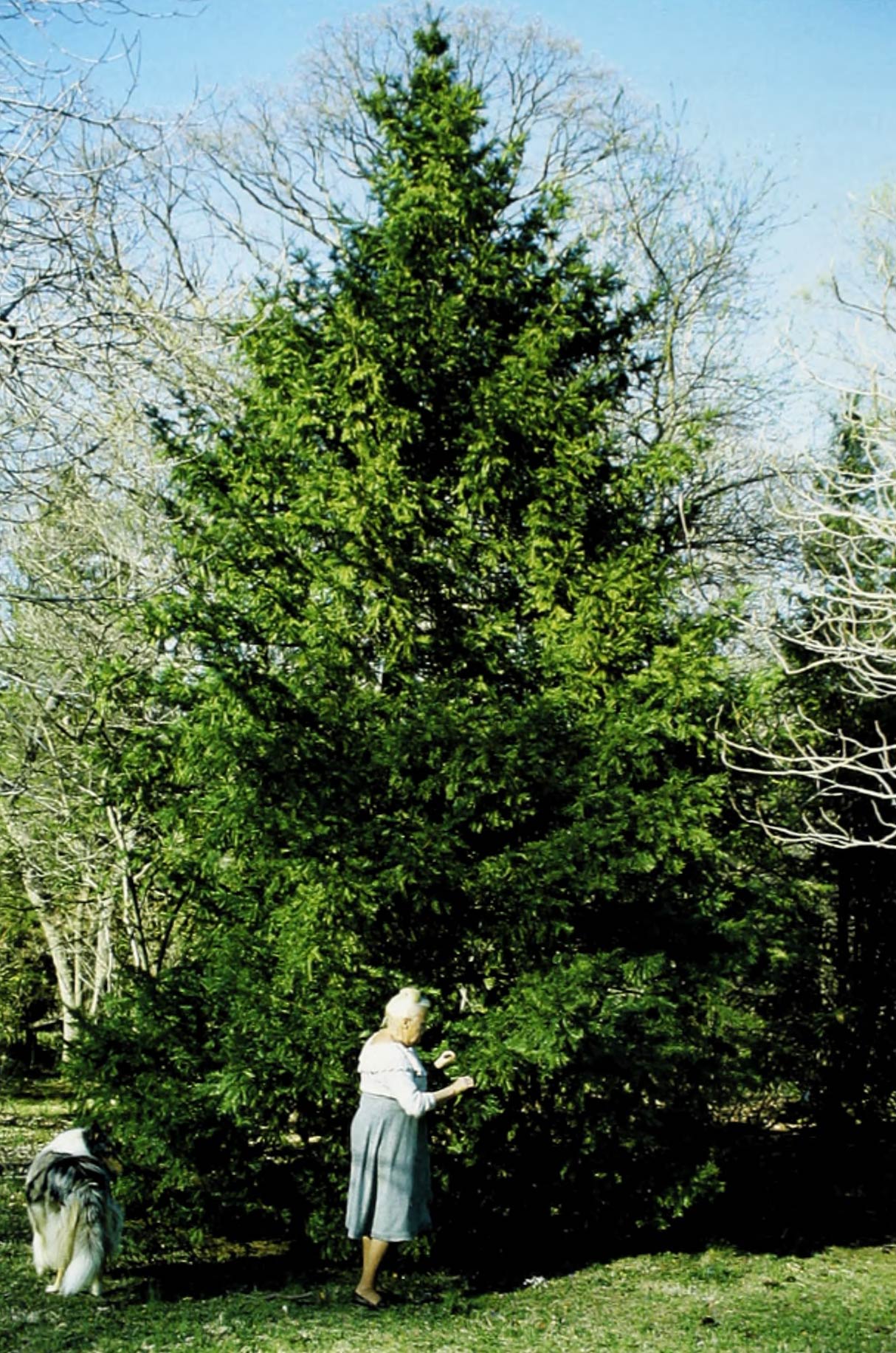
Perhaps the best evidence that florida torreya may be suffering from an inability to track climate change is that before the blight took hold, this tree was planted hundreds of miles north of its Florida habitat in the mountains of North Carolina, near Asheville. There, on the Biltmore Estate, the torreyas are thriving, and the females produce abundant seeds. “Flower beds often abound with seedlings ’planted’ by squirrels,” reports Bill Alexander, landscape historian at the Biltmore. During his 23 years there, Alexander has watched the torreyas stand up well to a five-year drought. And in the winter of 1985 the thermometer plunged to minus-20 degrees Fahrenheit, yet “our trees smiled right through,” he told me.
For a number of years, Alexander had been thinking that “florida” torreya really belonged back in North Carolina. So he was delighted to hear of the lost-disperser theory. A megafaunal ghost? If so, the ghost may well be a large extinct tortoise, I suggested, as reptiles are far more tolerant of plant terpenes than are mammals, and as the thin “shell” protecting the large single seed of this conifer offers scant protection against molars.
One must not, however, ponder the plight of the florida torreya in isolation from its sister species. In contrast to Torreya taxifolia, California’s torreya (Torreya californica) is maintaining its population, as are the several Asian species of Torreya—all of which bear nearly identical propagules. Nevertheless, all occupy restricted geographic ranges. What if the entire genus lost its key dispersers and now depends on the local activities of squirrels?
Bill Alexander and I easily came up with two plausible explanations for the differences in endangerment, based strictly on geographic differences. In eastern North America, the climatic effects of the Ice Sheet reached much farther south than was the case in either western North America or eastern Asia, forcing the Appalachian species to take refuge at a lower latitude. Perhaps even more significant is that latitudinal migration was the only option for florida torreya as the climate warmed. In contrast, torreya species in California and in Asia could head upslope. These torreyas are native to mountainous regions, where altitudinal gain facilitated by nothing more than squirrels could help the trees keep pace with a warming climate.
Such unsubstantiated and untested leaps of speculation are normally not well received within the scientific community—but these are not normal times. Without some drastic breakthrough in the management of Florida’s wild population of torreya trees, Torreya taxlfolia will, within fifty years, almost surely be extinct outside of botanical gardens. Perhaps it is time to help this torreya gain rootholds of wild populations in the mountains of North Carolina.
Such is not, alas, how things are done with endangered species—the exception being the recent return of the california condor to its Pleistocene home near the Grand Canyon. Native territory is regarded as the last best place to be. But what is “native”? How far might we justifiably reach back in time for a benchmark?
In a study of endangered species published in 2000, Rob Channell and Mark Lomolino concluded that “most species examined persist in the periphery of their historical geographic ranges.”11 If habitat at the periphery of historical range is adequate but not ideal, then the last place a troubled species is found may not, in fact, be the best place to assist its recovery.
Citation: Barlow, C. 2001. Anachronistic fruits and the ghosts who haunt them. Arnoldia, 61(2): 14–21.
Transplantation across great distances is an uncommon and controversial technique for biodiversity conservation today. But as the greenhouse effect ratchets up temperatures and reroutes rainfall, and as botanical preserves become even more isolated islands in a sea of human development, long-distance transplantation will become the norm. If gardening a few local patches of endangered plants is tough today, it’s going to get a lot tougher when, like it or not, we become gardeners of the planet.12 Helping plants track climate change from one patch of habitat to another will be a routine tactic for conserving biodiversity decades hence. Is it too early to begin now with florida torreya?
Acknowledgments
I wish to thank Dan Janzen, Paul Martm, Bill Alexander, Robert Timm, and Frank Schambach for helpful critiques, comments, and anecdotes.
Notes
1. In the June 8, 2001, issue of Science, two papers confirmed the “overkill hypothesis” of end-Pleistocene extinctions, one for Australia and the other for North America. The North American paper is John Alroy, 2001, “A multispecies overkill simulation of the end-Pleistocene megafaunal mass extinction,” 292 1893-1896. A news report by Leigh Dayton published in the same issue (p. 1819), “Mass extinctions pinned on ice age hunters,” suggests that this view is now the majority position.
2. Stephen T. Jackson and Chengyu Weng, 1999, “Late Quaternary extinction of a tree species in eastern North America,” Proceedings of the National Academy of Science 96. 13847-14852.
3. Dan Janzen’s suggestion that fleshy-fruited plants may have gone extinct since the end of the Pleistocene is m Connie Barlow, 2001, The Ghosts of Evolution (New York: Basic Books), 88
4. D H. Janzen and P. S Martin, 1982, “Neotropical anachronisms: The fruits the gomphotheres ate,” Science 215: 19-27.
5. For the story of how Janzen and Martin developed their ideas and conducted their fieldwork, see chapters 1-3 of the author’s Ghosts of Evolution, op cit.
6. Robert E. Cook, 1982, “Attractions of the flesh,” Natural History 91 (1): 20-24.
7. Martrn N. Tchamba and Prosper M. Seme, 1993, “Diet and feeding behavior of the forest elephant m the Santchou Reserve, Cameroon,” African Journal of Ecology 31: 165-171.
8. The theory that osage orange, prior to European colonization, occupied a very restricted range is presented in Frank F. Schambach, 2000, “Spiroan traders, the Sanders Site, and the Plains Interaction Sphere,” Plains Anthropologist 45 7-33.
9. Mark W Schwartz, Sharon M. Hermann, and Philip J. Van Mantgem, 1999, “Population persistence in Florida Torreya,” Conservation Biology 14. 1023-1033.
10. See p. 229 of The Ghosts of Evolution.
11. Rob Channell and Mark V. Lomolino, 2000, “Dynamic biogeography and conservation of endangered species,” Nature 403: 84-86
12. D. H. Janzen, 1998, “Gardenification of wildland nature and the human footprint,” Science 279: 1312- 1313.
Connie Barlow is a science writer and author of The Ghosts of Evolution Nonsensical Fruits, Missing Partners, and Other Ecological Anachromsms, published in 2001 by Basic Books.
From “free” to “friend”…
Established in 1911 as the Bulletin of Popular Information, Arnoldia has long been a definitive forum for conversations about temperate woody plants and their landscapes. In 2022, we rolled out a new vision for the magazine as a vigorous forum for tales of plant exploration, behind-the-scenes glimpses of botanical research, and deep dives into the history of gardens, landscapes, and science. The new Arnoldia includes poetry, visual art, and literary essays, following the human imagination wherever it entangles with trees.
It takes resources to gather and nurture these new voices, and we depend on the support of our member-subscribers to make it possible. But membership means more: by becoming a member of the Arnold Arboretum, you help to keep our collection vibrant and our research and educational mission active. Through the pages of Arnoldia, you can take part in the life of this free-to-all landscape whether you live next door or an ocean away.

